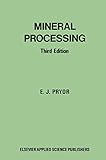Mineral processing [Libro electrónico] / E. J. Pryor
Por: Pryor, E. J [autor/a].
Tipo de material: Libro
en línea Editor: New York: Elsevier, c1965Descripción: ix, 844 páginas : ilustraciones ; centímetros.ISBN: 9401029431; 9789401029438; 9789401029414 (Online).Nota de acceso: Disponible para usuarios de ECOSUR con su clave de acceso Nota de bibliografía: Incluye bibliografía e índice: páginas 25-844 Número de sistema: 57004
Libro
en línea Editor: New York: Elsevier, c1965Descripción: ix, 844 páginas : ilustraciones ; centímetros.ISBN: 9401029431; 9789401029438; 9789401029414 (Online).Nota de acceso: Disponible para usuarios de ECOSUR con su clave de acceso Nota de bibliografía: Incluye bibliografía e índice: páginas 25-844 Número de sistema: 57004| Tipo de ítem | Biblioteca actual | Colección | Signatura | Estado | Fecha de vencimiento | Código de barras |
|---|---|---|---|---|---|---|
| Libros | Biblioteca Electrónica Recursos en línea (RE) | Acervo General | Recurso digital | ECO400570049415 |
Incluye bibliografía e índice: páginas 25-844
Glosario: páginas 809-818
Disponible para usuarios de ECOSUR con su clave de acceso
Basic description is attempted, and the bibliography has been specifically chosen to guide the reader toward a fuller treatment of his special ised interests. No fully satisfactory term has yet emerged to describe the processing of minerals, which is also called "ore dressing", "mineral dressing", "mineral engineering" and, in the University of London degree course "mineral technology". The dressing of ores was an excellent description of the older processes which aimed to break down rock to appropriate sizes, grade it, and separate the heavy fraction from the light one in each grade or size by gravity methods. The work done in the mill today goes far beyond these simple operations, and requires some knowledge of physical chemistry, particularly the branches which deal with the physics and chemistry of surfaces and of the interphase between solid particle and the surrounding liquid. At the same time, the engineer must not become so absorbed in the study of fundamental and applied technology as a physico-chemical science that he overlooks the mechanical, economic, and humanistic aspects oli his work. He is an engineer, a chemist, a physicist, and an administrator and, as such, should have a sound scientifj. c and cultural education. Technically, his work is to extract the valuable minerals from the ore sent to his mill; economically, it is to balance all the financial costs and returns in such a way as to ensure the maximum profit from the operation. eng
Disponible en línea
Disponible en formato PDF
Subscripción a ELSEVIER 26 de diciembre del 2013
